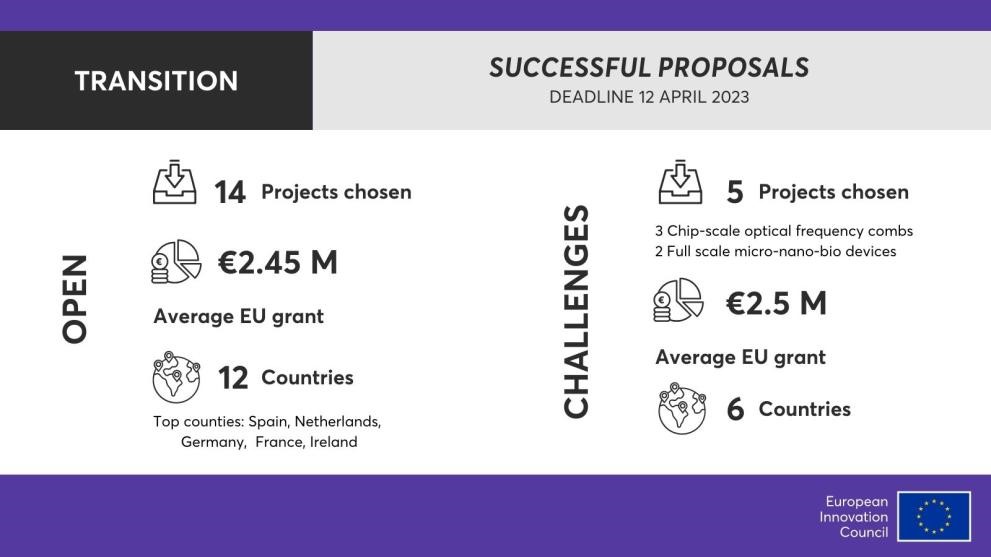The European Innovation Council (EIC) has selected 19 projects following the April 2023 EIC Transition cut-off. These successful proposals, selected among 180 eligible submissions, will receive altogether €46.76 million of EU financial contribution (up to €2.5 million each). The selected participants come from 18 EU Member States and Horizon Europe associated countries.
This latest EIC Transition call included ‘open’ funding, available for proposals on any field of science or technology. This was complemented with targeted funding for three specific challenges.
EIC Transition funding provides follow up funding to results achieved by EIC Pathfinder and ERC projects, and for the first time the call for challenge funding was open to projects that follow up results achieved by any project under Horizon.
The 19 selected projects consist of:
- 14 under the open funding,
- 3 under the “Chip-scale optical frequency combs” challenge,
- 2 under the “Full scale micro-nano-bio devices for medical and medical research applications” challenge,
- No projects were selected for the “environmental intelligence” challenge, but the budget remains available under the next cut-off.
Some examples of projects are:
- NextMRI – Truly portable MRI for extremity and brain imaging anywhere & everywhere
The EU-funded Histo-MRI and PR Scanner projects have recently demonstrated in vivo images taken with a light, small footprint, low-field extremity MRI scanner outside the controlled settings provided by medical facilities. This included the first-ever MRI images obtained at a patient’s home and even in open air, connected to a gasoline generator. The NextMRI project will take the necessary technical, industrial, and entrepreneurial steps to tackle the massive deployment of low-field portable systems for point-of-care and bedside imaging in large and small clinics large, home and hospice care, rural areas, sports facilities, events, etc. This will make MRI available to a large fraction of the world population who currently have no or insufficient access. To advance towards this highly ambitious goal, the objectives of the NextMRI project include: i) expanding the current technology to both extremity and brain imaging; ii) improving the diagnostic capabilities with machine learning; iii) improving the portability and usability to meet end-user needs; iv) optimising production costs; v) gathering medical evidence of the technology performance with clinical trials; and vi) developing a sustainable business case and model towards commercialisation.
- Nano4Rare – Preclinical development of a nanomedicine candidate for Fabry rare disease treatment to enter clinical phase
The Nano4Rare team has developed a patent-protected nanoencapsulation Key Enabling Technology for the development of cost-effective therapies for rare diseases, based on biomolecules. The Nano4Rare team has successfully used this technology for the development of a new patent-protected medicinal product candidate, named nanoGLA, for the treatment of Fabry disease, which is one of the most devasting LSD rare diseases. NanoGLA has been designated, in January 2021, as Orphan Drug by the European Medicine Agency (EMA) and the European Commission. Under the EU-funded Phoenix project, nano-GLA production will be scaled-up and brought to GMP conditions. As a first objective, the Nano4Rare project will use nanoGLA engineered batches produced in the frame of the Phoenix project to complete the preclinical phase and generate sufficient quality data on safety, efficacy, and quality to get approval by regulators to proceed with the clinical phase. As a second objective, a new spin-off company will be created for the advancement of nanoGLA towards the market and the commercialisation of the patent protected nanoencapsulation platform to generate new product candidates for rare disease treatments.
Source: European Innovation Council | News (https://rb.gy/zl51z)
